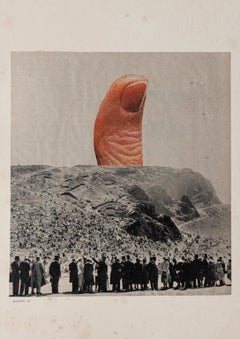1991 Gucci Watch
1970s Modern More Art
Paper
Sergio Barletta for sale on 1stDibs
Sergio Barletta is an Italian cartoonist and illustrator who has also published some humorous and political satire books. From the age of 22, he was active in Rome, where he worked as an illustrator and art director in some monthly magazines like Costume, Diners ClubHouse Organ, BP Review, IBM and others. In 1965, Barletta started working with Marino Gallery in Rome; in 1966, in Milan, with Humour Graphics group; at Levi Gallery and others in the following years. During these years, Barletta's graphic work and illustration mixed with painting and photography, and also with satirical drawings for Rinascita, weekly of the Italian communist party; Azione Sociale, weekly of ACLI Catholic Workers Association; movie posters, advertising for Gucci, some writings for Popular Photography Italiana, layouts, writings and illustrations for Avinews, bimonthly for tour operators and so on.
During the 1980s, Barletta began a long collaboration with satirical weekly Il Sale, complemented by a book with Ottaviano Edizioni in Milan and other publications in Turin and Rome, all of satirical drawings. During this period he collaborated with linus, the most important Italian comics monthly, and Harakiri, a humor weekly published in France.
A Close Look at modern Art
The first decades of the 20th century were a period of artistic upheaval, with modern art movements including Cubism, Surrealism, Futurism and Dadaism questioning centuries of traditional views of what art should be. Using abstraction, experimental forms and interdisciplinary techniques, painters, sculptors, photographers, printmakers and performance artists all pushed the boundaries of creative expression.
Major exhibitions, like the 1913 Armory Show in New York City — also known as the “International Exhibition of Modern Art,” in which works like the radically angular Nude Descending a Staircase by Marcel Duchamp caused a sensation — challenged the perspective of viewers and critics and heralded the arrival of modern art in the United States. But the movement’s revolutionary spirit took shape in the 19th century.
The Industrial Revolution, which ushered in new technology and cultural conditions across the world, transformed art from something mostly commissioned by the wealthy or the church to work that responded to personal experiences. The Impressionist style emerged in 1860s France with artists like Claude Monet, Paul Cézanne and Edgar Degas quickly painting works that captured moments of light and urban life. Around the same time in England, the Pre-Raphaelites, like Edward Burne-Jones and Dante Gabriel Rossetti, borrowed from late medieval and early Renaissance art to imbue their art with symbolism and modern ideas of beauty.
Emerging from this disruption of the artistic status quo, modern art went further in rejecting conventions and embracing innovation. The bold legacy of leading modern artists Georges Braque, Pablo Picasso, Frida Kahlo, Salvador Dalí, Henri Matisse, Joan Miró, Marc Chagall, Piet Mondrian and many others continues to inform visual culture today.
Find a collection of modern paintings, sculptures, prints and other fine art on 1stDibs.
